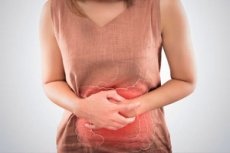Medical expert of the article
New publications
Diarrhea, vomiting and fever
Last reviewed: 29.06.2025

All iLive content is medically reviewed or fact checked to ensure as much factual accuracy as possible.
We have strict sourcing guidelines and only link to reputable media sites, academic research institutions and, whenever possible, medically peer reviewed studies. Note that the numbers in parentheses ([1], [2], etc.) are clickable links to these studies.
If you feel that any of our content is inaccurate, out-of-date, or otherwise questionable, please select it and press Ctrl + Enter.

A significant number of diseases and pathological conditions are manifested by such symptoms as diarrhea, vomiting and fever, which are often combined with nausea and abdominal pain of various localizations.
Causes of the diarrhea, vomiting and fever
If vomiting, diarrhea, and fever occur in an adult, in many cases the cause is food poisoning, which develops after ingestion of any food contaminated with bacteria in the GI tract, [1] including: enteropathogenic and enterotoxigenic strains of Escherichia coli; Salmonella (Samonella enterica and Salmonella bongori);- Campylobacter (Campylobacter jejuni); Yersinia (Yersinia enterocolitica); Shigella dysenteriae; Listeria monocytogenes; Staphylococcus aureus, whose toxins cause symptoms of food poisoning. [2]
Also see: causes and agents of food poisoning
Diarrhea, vomiting and fever in pregnancy can also be caused by food toxic infections, as well as intestinal infections.
Symptoms such as vomiting, nausea, diarrhea and fever can also be nitrate poisoning (nitric acid salts used as fertilizer), [3] and drug poisoning.
The body reacts in a similar way to some viral infections. First of all, this is rotavirus infection, caused by rotavirus (Rotavirus) of the Reoviridae family. It is this infection that is often associated with vomiting, diarrhea and fever in preschool and elementary school-aged children. [4], [5]
Rotavirus infection causes watery yellow diarrhea, vomiting and fever, which may be accompanied by abdominal cramps. Read more in the publication - rotavirus infection in children [6]
In adults, in addition to rotavirus, noroviruses (Norwalk virus) of the Caliciviridae family have been implicated in the development of inflammation of the GI tract (including the stomach and intestines) - viral gastroenteritis, also defined as intestinal flu. noroviruses (Norwalk virus) of the Caliciviridae family [7], [8]
Vomiting and diarrhea without fever can be caused by cholera, [9] as well as parasitic diseases such as teniasis (which develops when the intestines are infected by the swine chainworm, Taenia solium) [10] or tenyrhynchosis (caused by the bovine chainworm, Taeniarhynchus saginatus). [11]
Also useful information in the material - vomiting with diarrhea in a child without fever
Vomiting and fever without diarrhea can be etiologically associated with streptococcal sore throat or pharyngitis (which are caused by Streptococcus pyogenes - beta-hemolytic streptococcus group A); [12] acute viral hepatitis or meningitis (inflammation of the brain membranes) of viral origin. Read more - vomiting and fever in a child without diarrhea
Abdominal pain, diarrhea, vomiting and fever in appendicitis, exacerbation of gastritis, crohn's disease, intestinal protozoal infections, particularly those caused by coccidia of the genus Cryptosporidium cryptosporidiosis. [13]
Severe epigastric pain (in the left subcostal region), vomiting bile, diarrhea and fever (up to +37.5-38°C) are characteristic of acute pancreatitis. [14]
If there is vomiting, diarrhea and fever at sea, then the suspicion of food toxicoinfection, as a rule, arises first, although, perhaps, so the body (especially children's) reacts to the change in climatic conditions, and it may be signs of acclimatization. [15]
Pathogenesis
The pathophysiologic mechanism of vomiting and fever is the activation of a nonspecific immune response, which begins with phagocytosis of the pathogen that has entered the body by immune cells in the blood and tissues - macrophages and neutrophils - and the attraction of more leukocytes to the site of infection, leading to an inflammatory response. This is a complex reaction in which T cells (a special type of white blood cell) and macrophages release pro-inflammatory cytokines and cause the immune system to fight the infection.
As a protective reflex of the body, vomiting - due to irritation of the vomiting center of the medulla oblongata and the reciprocal increase in contractions of the intestine and muscle fibers of the peritoneum and diaphragm - allows the removal of toxic substances from the GI tract.
Increases the body's defense mechanisms and increases body temperature, which occurs when the hypothalamic thermoregulation center changes its setting. As a result, blood from the skin surface moves inside the body, which reduces heat loss. Promoting the production of interferons, proteins that trigger the eradication of pathogens.
And diarrhea (diarrhea) develops when the membranes of intestinal epithelial cells and their microvilli are damaged by viruses and bacteria (and their toxins), as a result of which the process of absorption of water from the intestinal lumen is disturbed, leading to liquefaction of feces.
Diagnostics of the diarrhea, vomiting and fever
An etiologically related disease is determined based on the presenting symptoms, history and laboratory results.
Tests such as general and biochemical blood tests, blood tests for eosinophils, total bilirubin, alkaline phosphatase, pancreatic amylase; blood tests for IgG and IgE antibodies, hepatitis virus antigens; serum bacterial culture and serologic blood tests; stool analysis (with bacterial examination); if meningitis is suspected, cerebrospinal fluid is examined.
Instrumental diagnostics may be used: gastroscopy, ultrasound or abdominal CT scan, gastric endoscopy, gastric x-ray and liver, pancreatic ultrasound, rectoscopy.
To identify the true cause of these symptoms, differential diagnosis is performed.
Also read:
Who to contact?
Treatment of the diarrhea, vomiting and fever
How to treat diarrhea, vomiting and fever?
To eliminate toxic agents from the GI tract is used enterosorption: drugs of the group of intestinal adsorbents (Enterosgel, polysorb, Sorbex, etc.). And to avoid dehydration of the body with loss of electrolytes is rehydration (with oral administration of Ringer-Locke solution, rehydron and other rehydration agents). In more severe cases, intravenous fluid administration may be required.
More details in the publications:

